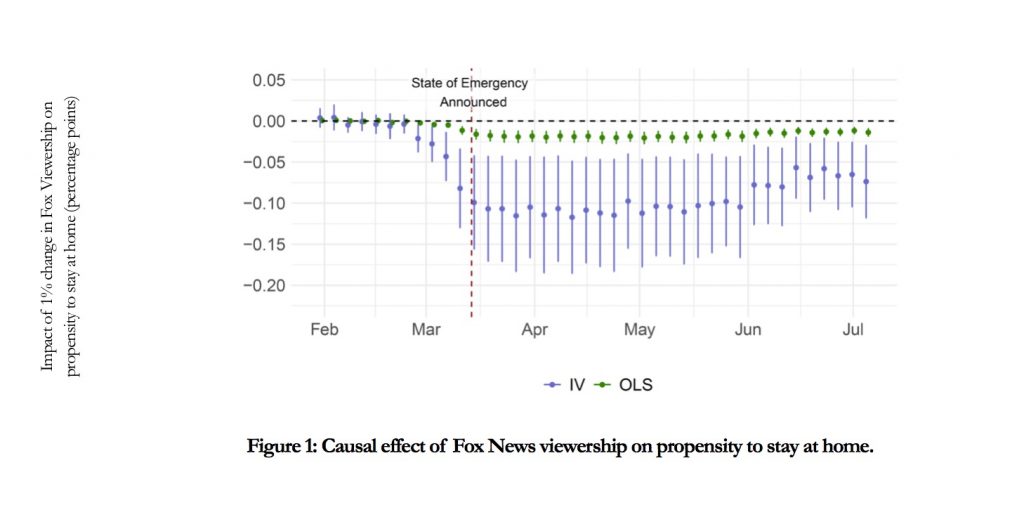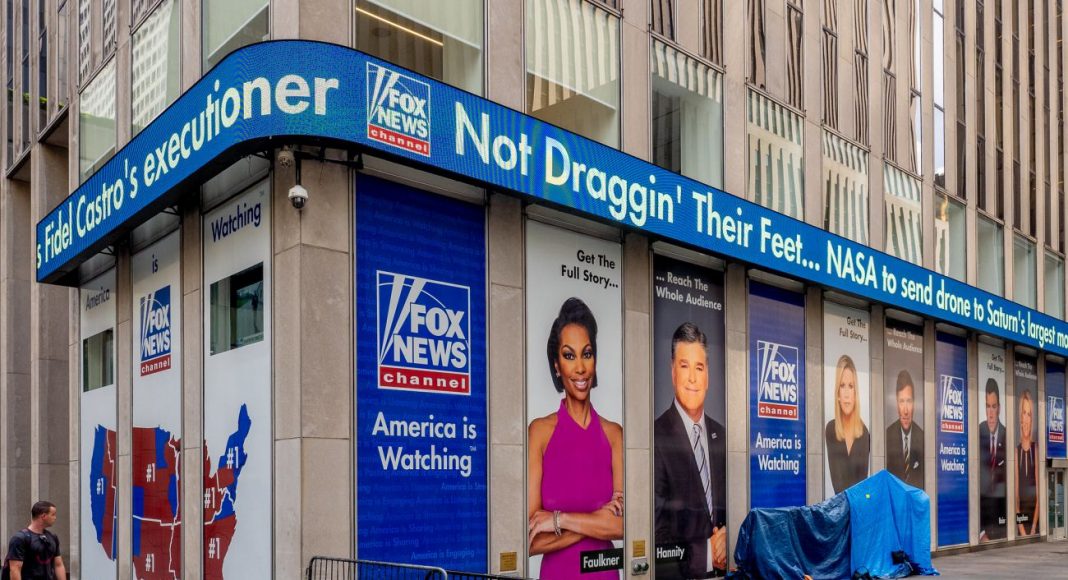Using zip-code level data on Fox News viewership and individual cellphone movement data, a recent study finds that increasing the local viewership of Fox News caused less compliance with social distancing behavior during the first few months of the Covid-19 pandemic in the US. The estimates imply a Fox News persuasion rate—the ability to convert the behavior of viewers who would have complied with social distancing guidelines but for their exposure to Fox News—of up to 28 percent. These findings suggest renewed concern about the media’s role in the sowing distrust in scientific experts and scientific evidence in the determination of public policies.
The striking differences in compliance with social distancing policies across the US have been associated with a range of factors, including socio-demographic traits, perceptions of risk, political polarization, and even civic duty.
However, with 49 percent of Americans relying on televised news as their primary source of current events, the mixed coverage across the leading networks—Fox News, CNN, and MSNBC—raises concerns about the potential role of media persuasion and news misinformation.
By mid-March, the White House had declared a national emergency and endorsed the scientific community’s policies of containment: “Social distancing: That’s the way you win.” Nevertheless, Fox News, the nation’s leading television news outlet, continued to challenge the efficacy of social distancing and the integrity of the scientific community’s recommendations well into the spring. Fox News host Laura Ingraham lashed out at “so-called experts” and their “lame pandemic-inducing models.” A “slew of Fox News opinion hosts and anchors [were] pushing back on public health experts and urging President Donald Trump to abandon its social distancing policies and reopen the economy.”
The key obstacle to testing for a persuasive effect of news media on viewer behavior is the unavoidable self-selection of viewers for a specific network. It would be all but infeasible to conduct a large-scale field experiment that randomly assigns viewers to different news outlets.
Instead, our paper, The Persuasive Effect of Fox News: Non-Compliance with Social Distancing During the Covid-19 Pandemic, devises a quasi-experimental design. We exploit the quasi-random manner in which news channels were historically assigned a numerical channel position across the more than 2,000 US cable systems. Indeed, viewership for any given channel (not just Fox News) falls almost linearly for larger numeric positions, moving away from 1. We match these viewership data with the local measures of social distancing constructed using the daily movement behavior of a panel of millions of individual cell phones. Our empirical strategy consists of correlating the incremental viewership of a news channel due to its channel position with local compliance in social distancing during the Covid-19 crisis.
We plot the time series of our estimated four-day Fox News viewership effects on social distancing between February and June 2020 in Figure 1. The effect approximately measures the impact of a 1 percent change in viewership in a ZIP code on the propensity to stay at home in percentage points. We only start to detect a Fox News effect around February 29th, the day the state of Washington issued the first emergency declaration in the US. The Fox News effect increases in magnitude until March 13th, the date the White House declared a national emergency.
The effect increases in magnitude until March 13th, at which point it stabilizes throughout the remainder of the Spring. On an average day during this period, a 10 percent increase in Fox News viewership in a given ZIP code caused a 1.3 percentage-point decline in social distancing compliance.

At first glance, we cannot be certain that our estimates reflect a direct effect of Fox News viewership on social distancing compliance. For instance, past work has shown that Fox News viewership polarizes audiences towards the Republican party (Martin and Yurukoglu, 2017). Since political polarization is also associated with social distancing compliance (e.g., Allcott et al., 2020, and Barrios et al., 2020), a potential concern is that our effects may be capturing, in part, political polarization as opposed to a persuasive effect of the coverage of Covid-19.
However, as explained above, the effects during March and April coincide with the period during which President Trump supported social distancing and lockdown measures. Moreover, if we split the ZIP codes into terciles based on the voter share for the Republican party during the 2016 elections, we find large and significant Fox News effects within the most Democrat-leaning areas. In contrast, the Fox News effects are small and insignificant in the most Republican-leaning areas. These findings suggest that Fox News is most persuasive in areas that are more polarized in favor of the Democratic party, areas that previous research has found to be the most compliant with social distancing, as discussed above.
“The most striking aspect of our findings is that the Fox News effect persuades viewers to disregard expert advice and evidence from the scientific community.”
Our findings also imply a large persuasive effect of Fox News on its viewers. The implied persuasion rate—the ability to convert the behavior of those Fox News viewers who would have complied but for their exposure to Fox News broadcasts—was as high as 28 percent during the spring of 2020. This magnitude aligns with previous work that measured a large persuasion rate for Fox News viewership on voting behavior during the 2004 and 2008 presidential elections (Martin and Yurukoglu, 2017).
While we do not attribute the Fox News effects to health outcomes, namely cases and deaths, multiple studies have emerged since the start of the outbreak indicating the importance of social distancing for containing the spread of disease.
The most striking aspect of our findings is that the Fox News effect persuades viewers to disregard expert advice and evidence from the scientific community. These findings suggest that the news media may be playing a role in the worrisome trend of distrust in scientists and scientific evidence in the US, dating back to the 1970s.
Regardless of the accuracy and reliability of evidence supporting social distancing policies, we see a cause for concern if many US households turn to televised news as their second opinion when the scientific community presents evidence that is inconsistent with viewers’ personal beliefs. This distrust could have dire consequences for the ability of leaders to generate public support for policies that rely on scientific evidence to improve the health and wellbeing of their constituents.






